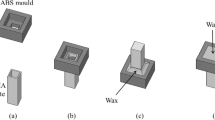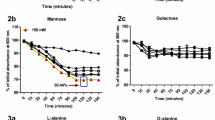Abstract
Bacillus anthracis makes highly stable, heat-resistant spores which remain viable for decades. Effect of various stress conditions on sporulation in B. anthracis was studied in nutrient-deprived and sporulation medium adjusted to various pH and temperatures. The results revealed that sporulation efficiency was dependent on conditions prevailing during sporulation. Sporulation occurred earlier in culture sporulating at alkaline pH or in PBS than control. Spores formed in PBS were highly sensitive towards spore denaturants whereas, those formed at 45°C were highly resistant. The decimal reduction time (D-10 time) of the spores formed at 45°C by wet heat, 2 M HCl, 2 M NaOH and 2 M H2O2 was higher than the respective D-10 time for the spores formed in PBS. The dipicolinic acid (DPA) content and germination efficiency was highest in spores formed at 45°C. Since DPA is related to spore sensitivity towards heat and chemicals, the increased DPA content of spores prepared at 45°C may be responsible for increased resistance to wet heat and other denaturants. The size of spores formed at 45°C was smallest amongst all. The study reveals that temperature, pH and nutrient availability during sporulation affect properties of B. anthracis spores.



Similar content being viewed by others
References
Amiteye S, Kobayashi K, Imamura D, Hosoya S, Ogasawara N, Sato T (2003) Bacillus subtilis diacylglycerol kinase (DgkA) enhances efficient sporulation. J Bacteriol 185:5306–5309
Byrer DE, Rainey FA, Wiegel J (2000) Novel strains of Moorella thermoacetica form unusually heat-resistant spores. Arch Microbiol 174:334–339
Douki T, Setlow B, Setlow P (2005) Photosensitization of DNA by dipicolinic acid, a major component of spores of Bacillus species. Photochem Photobiol Sci 4:591–597
Driks A (1999) Bacillus subtilis spore coat. Microbiol Mol Biol Rev 63:1–20
Driks A (2003) The dynamic spore. Proc Natl Acad Sci USA 100:3007–3009
Gerhardt P, Marquis RE (1989) Spore thermoresistance mechanisms. In: Smith I, Slepecky RA, Setlow P (eds) Regulation of prokaryotic development. ASM, Washington, DC, pp 43–63
Gustavsson N, Diez A, Nystrom T (2002) The universal stress protein paralogues of Escherichia coli are co-ordinately regulated and co-operate in the defence against DNA damage. Mol Microbiol 43:107–117
Helfinstine SL, Vargas-Aburto C, Uribe RM, Woolverton CJ (2005) Inactivation of Bacillus endospores in envelopes by electron beam irradiation. Appl Environ Microbiol 71:7029–7032
Ireland JA, Hanna PC (2002) Amino acid- and purine ribonucleoside-induced germination of Bacillus anthracis Delta-Sterne endospores: gerS mediates responses to aromatic ring structures. J Bacteriol 184:1296–1303
Klein F, Walker JS, Fitzpatrick DF, Lincoln RE, Mahlandt BG, Jones WI Jr, Dobbs JP, Hendrix KJ (1966) Pathophysiology of anthrax. J Infect Dis 116:123–138
Liu H, Bergman NH, Thomasson B, Shallom S, Hazen A, Crossno J, Rasko DA, Ravel J, Read TD, Peterson SN, Yates J, Hanna PC (2004) Formation and composition of Bacillus anthracis endospores. J Bacteriol 186:164–178
Margosch D, Ehrmann MA, Buckow R, Heinz V, Vogel RF, Ganzle MG (2006) High-pressure-mediated survival of Clostridium botulinum and Bacillus amyloliquefaciens endospores at high temperature. Appl Environ Microbiol 72:3476–3481
Marquis RE, Shin SY (1994) Mineralization and responses of bacterial spores to heat and oxidative agents. FEMS Microbiol Rev 14:375–379
Marquis RE, Sim J, Shin SY (1994) Molecular mechanisms of resistance to heat and oxidative damage. Soc Appl Bacteriol Symp Ser 23:40S–48S
McDougald D, Gong L, Srinivasan S, Hild E, Thompson L, Takayama K, Rice SA, Kjelleberg S (2002) Defences against oxidative stress during starvation in bacteria. Antonie Van Leeuwenhoek 81:3–13
Melly E, Genest PC, Gilmore ME, Little S, Popham DL, Driks A, Setlow P (2002) Analysis of the properties of spores of Bacillus subtilis prepared at different temperatures. J Appl Microbiol 92:1105–1115
Movahedi S, Waites W (2000) A two-dimensional protein gel electrophoresis study of the heat stress response of Bacillus subtilis cells during sporulation. J Bacteriol 182:4758–4763
Nakata HM (1963) Effect of pH on intermediates produced during growth and sporulation of Bacillus cereus. J Bacteriol 86:577–581
Nicholson WL, Galeano B (2003) UV resistance of Bacillus anthracis spores revisited: validation of Bacillus subtilis spores as UV surrogates for spores of B. anthracis Sterne. Appl Environ Microbiol 69:1327–1330
Nicholson WL, Munakata N, Horneck G, Melosh HJ, Setlow P (2000) Resistance of Bacillus endospores to extreme terrestrial and extraterrestrial environments. Microbiol Mol Biol Rev 64:548–572
Paidhunghat M, Setlow B, Driks A, Setlow P (2000) Characterization of spores of Bacillus subtilis which lack dipicolinic acid. J Bacteriol 182:5505–5512
Perkins DN, Pappin DJ, Creasy DM, Cottrell JS (1999) Probability-based protein identification by searching sequence databases using mass spectrometry data. Electrophoresis 20:3551–3567
Powell JF (1953) Isolation of dipicolinic acid (pyridine-2:6-dicarboxylic acid) from spores of Bacillus megaterium. Biochem J 54:210–211
Rice EW, Adcock NJ, Sivaganesan M, Rose LJ (2005) Inactivation of spores of Bacillus anthracis Sterne, Bacillus cereus, and Bacillus thuringiensis subsp. israelensis by chlorination. Appl Environ Microbiol 71:5587–5589
Russell AD (1982) The destruction of bacterial spores. Academic, London
Sedlak M, Vinter V, Adamec J, Vohradsky J, Voburka Z, Chaloupka J (1993) Heat shock applied early in sporulation affects heat resistance of Bacillus megaterium spores. J Bacteriol 175:8049–8052
Setlow B, Loshon CA, Genest PC, Cowan AE, Setlow C, Setlow P (2002) Mechanisms of killing spores of Bacillus subtilis by acid, alkali and ethanol. J Appl Microbiol 92:362–375
Slieman TA, Nicholson WL (2001) Role of dipicolinic acid in survival of Bacillus subtilis spores exposed to artificial and solar UV radiation. Appl Environ Microbiol 67:1274–1279
Suzuki JB, Booth R, Grecz N (1971) In vivo and in vitro release of Ca45 from spores of Clostridium botulinum type A as further evidence for spore germination. Res Commun Chem Pathol Pharmacol 2:16–23
Topanurak S, Sinchaikul S, Phutrakul S, Sookkheo B, Chen ST (2005) Proteomics viewed on stress response of thermophilic bacterium Bacillus stearothermophilus TLS33. Proteomics 14:3722–3730
Van Ness GB (1971) Ecology of anthrax. Science 172:1303–1317
Weiner MA, Hanna PC (2003) Macrophage-mediated germination of Bacillus anthracis endospores requires the gerH operon. Infect Immun 71:3954–3959
Yazdany S, Lashkari KB (1975) Effect of pH on sporulation of Bacillus stearothermophilus. Appl Microbiol 30:1–3
Zaman MS, Goyal A, Dubey GP, Gupta PK, Chandra H, Das TK, Ganguli M, Singh Y (2005) Imaging and analysis of germination of Bacillus anthracis spores. Microsc Res Tech 66:307–311
Zhang W, Chait BT (2000) ProFound: an expert system for protein identification using mass spectrometric peptide mapping information. Anal Chem 72:2482–2489
Acknowledgments
The authors thank Philip. C. Hanna (University of Michigan) for his suggestions during the course of study and Ms Prabha Sarangi and Ribhu Nayar for technical support. Financial support by Council of Scientific and Industrial Research (SMM 0003) is acknowledged.
Author information
Authors and Affiliations
Corresponding author
Additional information
Communicated by Erko Stackebrandt.
Rights and permissions
About this article
Cite this article
Baweja, R.B., Zaman, M.S., Mattoo, A.R. et al. Properties of Bacillus anthracis spores prepared under various environmental conditions. Arch Microbiol 189, 71–79 (2008). https://doi.org/10.1007/s00203-007-0295-9
Received:
Revised:
Accepted:
Published:
Issue Date:
DOI: https://doi.org/10.1007/s00203-007-0295-9




